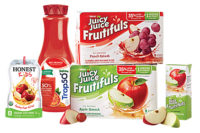Masking the goodness within

Functional formulations, such as FRS Healthy Energy’s line of Healthy Protein and Healthy Energy beverages, often require ingredient solutions to deliver the promised taste as well as efficacious doses of active ingredients.

Coca-Cola subsidiary Honest Tea launched a zero-calorie Classic Lemonade that is sweetened with organic stevia and also includes natural flavors. Ingredient suppliers note that stevia-sweetened beverages often require solutions to mask the sweetener’s aftertaste.

MillerCoors offered a limited-edition seasonal MGD 64 Lemonade, which was a light beer made with natural lemon flavor and sweetened with sucralose. Reduced-calorie alcohol beverages often require masking solutions, ingredient suppliers say.

Meal replacement and supplement-type beverages, such as Ensure Plus Immune Balance, often require solutions to help facilitate the indulgent taste profile through the beverage’s functional ingredients, such as protein, prebiotics and antioxidants.




Some parents and pet-owners have devised methods to hide medicine or supplements within the food and beverages consumed by their children and animals. These inventive methods parallel the behind-the-scenes work of flavor companies that collaborate with beverage-makers to increase the palatability of a new sweetener or functional formula.
The challenge is simple, says George Ennis, vice president and chief flavor chemist for David Michael & Co., Philadelphia.
“In general, beverage-makers are looking to make the best-tasting product for the most affordable cost,” Ennis says.
The prevalence of functional beverage formulations that feature vitamins, minerals, fiber, protein and more has led to more challenges for flavor houses, such as Virginia Dare, says Anton Angelich, group vice president-marketing for the Brooklyn, N.Y.-based company.
“A lot of nutritive and efficacious materials — vitamins, proteins, botanicals — at high levels just don’t taste good,” Angelich says. “When you think about the 40,000 or more SKUs in the average American supermarket, the consumer has a lot of choices. When they are watching their spending, they can be even choosier. Things have to taste really, really good.”
Robertet Flavors is one of several flavor manufacturers that is active with this side of the business, explains Suzanne Niekrasz, director of marketing communications for the Piscataway, N.J.-based company.
“A major effort of the flavor industry today involves the discovery and application of new molecules and flavor compounds that will deliver great taste in healthier products,” Niekrasz says. “The need to harmonize flavor ingredients with the many available sweeteners, vitamins and minerals, and other good-for-you ingredients has had a huge impact on R&D efforts, and will continue to drive innovation in flavor technologies for years to come.”
Range of options
David Michael’s masking solutions range from covering up the aftertastes of non-nutritive sweeteners and stevia, the taste of fiber, the metallic taste of minerals and vitamins, and in alcohol beverages, the tannins, flavonoids and sulfide notes, among other specialties.
The company’s beverage technologies group works in concert with creative flavor chemistry to identify the cause of non-conforming flavor notes, Ennis explains. Then flavor masking techniques are developed and applied to the beverage. Finally, the company’s sensory department initiates a test to validate the masking flavors’ effectiveness, he says.
Following development, David Michael’s flavor solutions are process-proven in the finished beverage and validated with sensory data collected from extensive organoleptic panels using panelists who are experts in description flavor analysis, Ennis explains.
Virginia Dare has been involved in the masking industry for decades, Angelich explains. The company began working with pharmaceutical companies that were based near its Brooklyn headquarters to mask medicinal ingredients before gel encapsulation and coatings, he says.
“We’ve been doing it a long time and we have about 80 different masking systems,” he says. “A lot of it is the art and the experience of the applications person that’s going to say, ‘I know if you’re putting niacin, thiamin and echinacea in there and some calcium, No. 39 is going to do the job.’ It’s really experience that tells you which ones you can do.”
Angelich says it would be ideal for a customer who is seeking a masking solution to come to Virginia Dare’s labs and work with its team.
“Let them bring the base and let us see their market research and what they are trying to accomplish,” he says. “Also, taste description articulation is very important — it’s very hard to speak the same language and lexicon in describing flavor notes and things, but when you’re tasting side-by-side and someone says, ‘Ah, that’s the note I’m talking about, that astringency,’ they both know what it is.”
Virginia Dare also conducts shelf-life tests with its masking solutions in order to verify the long-term performance of the ingredients.
Sweetener obstacles
As consumers continue to look for low- and no-calorie beverages, beverage-makers and ingredient suppliers alike have responded with natural and artificial sugar substitutes. However, the benefits of calorie reduction occasionally are accompanied by off-notes in taste and aftertaste. Ingredient suppliers have responded with solutions that help compensate for the sweeteners’ flavor drawbacks.
Flavor & Fragrance Specialties is creating new flavors all the time to serve as sweetness enhancers, flavor modifiers, and mouthfeel and alcohol enhancement solutions, explains Paul Riker, beverage applications specialist for the Mahwah, N.J.-based company. These solutions tie in with the trend for more natural clean label solutions as formulators opt to sweeten their products with natural sugar substitutes.
“This ties right in with the trend for natural, lower calorie sweeteners like stevia, agave and things like that,” says Alpa Roman, senior flavor chemist for Flavor & Fragrance Specialties. “They are all missing certain elements of a full sweetness profile.”
The challenge is to minimize the use of the sweetener by supplementing it with flavor enhancers and sweetness enhancers that are going to give the product more of a sugar profile, Riker says.
“Natural flavors, in general, have been around for a long time, so we have a full repertoire of natural flavors, but these sweetness enhancers and different modifiers, whether it be for mouthfeel or for alcohol enhancement, we’re constantly developing and
re-developing — trying to make a better mousetrap,” he says. “But cost also becomes an issue, so you kind of have to optimize your cost in use so people can afford these things. With the economy being what it is, everybody is trying to be economical.”
In addition to custom solutions, Flavor & Fragrance Specialties has shown customers a zero-calorie, stevia-sweetened beverage with a sweetness enhancement solution that gives the product a sugar-sweetened profile, Riker says.
California Custom Fruits & Flavors offers a sweetness enhancer that can trick the palate into thinking the consumer is ingesting more sugar than he or she actually is, explains Philip Barone Jr., director of flavor development for the Irwindale, Calif.-based company.
Although he notes that when stevia is used properly, very few off-notes will be present, Barone says, “For stevia-sweetened beverages, the sweetness enhancer helps to mask any off-notes brought on by stevia.”
Varied solutions
Some fortification options, such as fish-derived omega-3 fatty acids and botanicals, create particular challenges for masking solutions, explains Virginia Dare’s Angelich.
“If you’re putting botanicals or herbs in [a beverage], a lot of those things are bitter or have botanical types of notes,” he says. “And when you put them at efficacious levels for bioavailability, you have to put them at a high enough level that they’re going to have an impact. Our masking systems are things where it neutralizes them, it reduces the impact, and by doing that it’s kind of a clear frame and then you build on top of it whatever [flavor] you want to build on top of it.”
For some nutritious beverages, the masking solution helps to provide a base for flavor development, Angelich says.
“If you are talking about meal replacement beverages, many contain proteins, vitamins, electrolytes that make such products less palatable and hedonically pleasing,” he says. “They need masking to neutralize the taste of the base, from which you can build desirable finished indulgent flavor taste, such as Dulce de Leche, Caramel, Toffee and Butterscotch as well as Vanilla, Chocolate or Strawberry. These tastes fit well conceptually with these products.”
In addition to sweetener solutions, Flavor & Fragrance Specialties also has created options in line with the reduced calorie cocktail trend.
“The other trend that we’re seeing, too, is the skinny cocktail trend — it’s permeating everywhere,” Roman says. “Skinnygirl Margarita started the trend basically, but with that you see restaurants doing these skinny cocktail programs and there’s new product introductions that have reduced calories or reduced alcohol. With that comes a set of challenges, such as how do you sweeten the product? How do you augment the sweetness? Then also, how do you create that full alcohol impact without a lot of the calories?”
Riker notes that many of the calories are coming from the alcohol itself, but beverage-makers still want to have taste in a reduced-calorie alcohol beverage, he says.
“With some of the flavor chemicals we’ve been working with in developing the alcohol enhancement, it kind of gives you the sensation of more alcohol than is actually there,” he says.
At the other end of the spectrum, cost-conscious consumers are moving away from premium distilled beverages and turning to less expensive options, but still expecting a premium-type taste profile, Roman says.
“We’ve also developed technologies to smooth out a rougher alcohol base and its flavors to help make it more palatable,” she says.
Flavor & Fragrance Specialties works with customers who come to the company looking for solutions to their specific challenges. In those cases, they work with the base, which could include vitamins, minerals, proteins and any combination of ingredients, to create a masking solution for that application.
“It is best to work custom,” Riker says. “Everyone’s looking for a silver bullet, but unfortunately it’s not there, so it’s playing with combinations of natural extracts and flavor chemicals that we can get to the best place that we can.”
The company operates on a mantra of continuous improvement for its masking solutions, which Roman says Flavor & Fragrance Specialties is always “working on and upgrading.”
Masking solutions are one option to help beverage-makers fit in with consumer demands and industry trends, says Robertet Flavors’ Niekrasz.
“Overall, the big news is all the work that is being done with natural materials, with sweeteners and sweetener blends, and in selecting flavors and flavor modifiers to deliver beverages that are healthy, low-calorie and more exciting and flavorful than ever before,” she says. BI
Looking for a reprint of this article?
From high-res PDFs to custom plaques, order your copy today!










